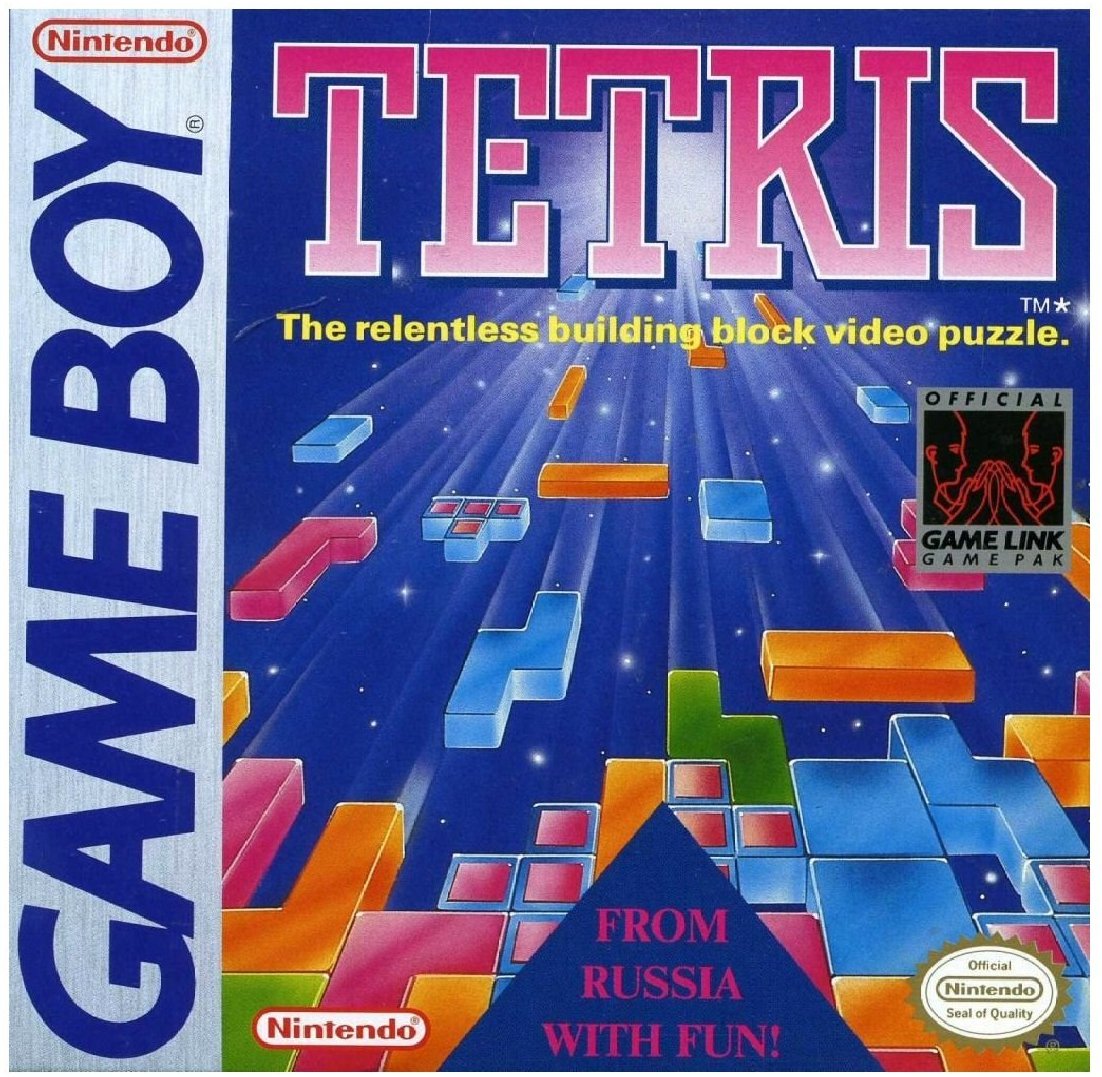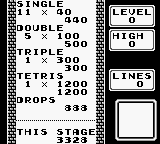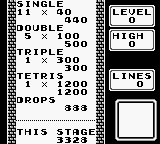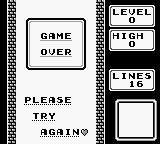Tetris

- Japanese release in June 1989
- Japanese release in June 1989
- North American release in July 1989
- Australian release in 1989
- European release in September 1990
- Asian release in 1990
- Korean release in 1990
- Brazilian release in 1993
- North American release in May 1996
- Japanese release in September 2000
- Developed by Nintendo
Ecstasy of Order

This is it. The game that single-handedly built the Game Boy as a viable, popular and beloved platform. Were Nintendo to have released the Game Boy with Tetris stuck in the system unable to play anything else this brand new portable system would have been a tremendous success, making Nintendo a nice sum of money. Indeed, when we look at the Game Boy with modern eyes the system appears underwhelming. These days everybody carries a phone. They’re easy to put in your pocket or your purse. Their usefulness is also readily apparent. But how could you justify lugging such a big unwieldy brick around in the ’90s?
Because of Tetris.
It might seem quaint in hindsight, but Tetris in 1989 was revolutionary. Puzzle games existed but they were mostly concerned with moving characters around mazes. Tetris was different because it made you place falling objects. It was the first of its kind, and it resonated with people immediately. It is so simple I’ll summarize it in a single sentence for you: Make lines by placing the Tetrominos. If you don’t know what Tetris is, go play it for a moment and you will immediately understand why so many people bought the Game Boy: the appeal of Tetris was that strong.
Tetris made Game Boy and Game Boy made Tetris. — Henk Rogers
System Builder
Tetris is the game that built the Game Boy. Without it, the release of the system does not have a game of truly universal appeal. When the Game Boy was originally released, the presence of Tetris on the system meant that business people, parents, children, basically anyone could enjoy the pea soup screen of the chunky Game Boy with an unparallelled experience. The main appeal of the revolutionary puzzle game, playing it in your palms, could not be achieved on any competitors’ machine since Tetris was exclusive to portable consoles made by Nintendo. To the layman, Tetris could even appear to have been invented by Nintendo. Except for the whole Russian theme the game has. While the match made in heaven was packed together in the same box in North America, Japan is a different story. Tetris did not come out at the same time as the system in Japan. The Game Boy came out in April with Super Mario Land, Alleyway, Baseball and Yakuman, a mahjong title. Tetris joined them two months later in June. I do not know exactly why that is, whether the game was simply not ready or something else more complicated. I tend to think it simply wasn’t finished in time because of the licensing history I’ll touch on later. Tetris was thus not bundled with the Game Boy but keep in mind that the Japanese market very rarely bundles games with systems. It’s a matter of marketing tradition and consumer expectations. I don’t think it would have been bundled even if it came out at the same time as the Game Boy.
I absolutely need to clarify that Tetris was not created for the Game Boy, merely adapted. The long and sordid story of Tetris leaving Motherland Russia and taking the rest of the world by storm is convoluted. Keeping it simple, Alexei Pajitnov created it in 1984 and it seeped to Europe and the rest of the West through home computer versions licensed and sub-licensed from the Soviet state. The British licensees got careless with their license, straight up acting like they owned the game, and licensed beyond what they had negotiated with the Soviets. Henk Rogers ended up with a Japanese video game console license that way. When he first saw the game, Hiroshi Yamauchi, Nintendo’s ruthless president, understood the match made in heaven between the upcoming Game Boy and Tetris. He then had Henk Rogers sent on Nintendo’s behalf to negotiate for portable consoles terms. Henk Rogers, founder of Bullet-Proof Software, was a rare westerner working successfully in the Japanese game market (he famously introduced the Japanese to RPGs with The Black Onyx) and he had come in contact with Tetris, had fallen in love and started paying for a Japanese licence from the supposed British sub-licensee of Pajitnov, the game’s creator. He traveled to Moscow to make sure the game could be published on Game Boy and discovered that Elektronorgtechnica (ELORG), the Soviet organization that owned Tetris because Pajitnov created the game at his job, had not licensed the game for console to anybody. Imagine that: Rogers was selling an illegal Famicom version according to the Soviets, and he learned it while trying to negotiate with them. Just as Henk had been able to get Yamauchi to trust him, he managed to convince the Soviets to trust him and he managed to secure a legitimate licence in 1989 from ELORG. He pissed off Atari in the process to the point where the fight between them and Nintendo over Tetris eventually had to go to court, and through that whole process Rogers became a lifelong friend and business partner of Pajitnov to this day.
My Personal Affair With Tetris
When I think of Tetris, I hear the sounds you hear when you start a game. I don’t mean the specific music you hear when you play a game of Tetris. I hear the bare minimum notes you need to hear on every screen before the game switches to the next one as you mash the A button. That’s how much I played Tetris: enough to recall, 25 years after first playing it, the specific sounds it makes as you quickly start it up. I owned a Game Boy for two years with Tetris as the only game. And I loved it. So when I say that Tetris is the most important game on Game Boy, I’m talking from experience.
The game features two modes, aptly titled A-Type and B-Type. A-Type is strictly a top score type of deal. You can select how fast you want the game to start at, but this is it. B-Type tasks you with getting the highest score possible while clearing out a maximum of 25 lines. As a score multiplier, you can choose a speed setting and spew random blocks on the play field. While those two types of gameplay are awfully limited today (Nintendo’s last Tetris version they developed themselves, Tetris DS, features six very intricate modes), Tetris set the standard for puzzle games for a decade. To top off this non-stop fun, the game features the same Russian-folklore stereotypes as all previous licensed versions of the game, including a rendition of folkloric Russian song Korobeiniki, now better known for being the Tetris music than for being a classical Russian song.
Weird fact, the first pressing of the Japanese version features some differences in the rule set and a different A song that isn’t Korobeiniki. It’s still mind-boggling to me and probably explained by the fact that Korobeiniki was first used on the Apple IIGS and Mac versions of Tetris before Nintendo made their own. They probably later realized that Tetris was already associated with the song and changed the A song for all subsequent pressings. It’s just a guess though.
Stronger Than Shigeru Miyamoto

Tetris on Game Boy is truly prescient. By merely bringing over the puzzle game to the Game Boy, Nintendo showed what it truly means to make a portable game. No need for Miyamoto to come in and invent what it means to make a game for Game Boy. The Famicom in Japan had very different games until Miyamoto came in and started literally expanding the boundaries of the console with games like Devil World, Ice Climber and, of course, Super Mario Bros. Nowadays a new Nintendo console means a Miyamoto produced title like Super Mario 64, Wii Sports, or Steel Diver will show everyone what the console is meant to do. The Game Boy did not see Miyamoto make a game for it until Wave Race in 1992. Miyamoto is thus completely absent as the trendsetter of the Game Boy library. This impacts Nintendo’s first portable console from its first title to its last. No other Nintendo console really had an absent Miyamoto, aside from the dreaded Virtual Boy. When he did show up with Game Boy games, he was the one who had to follow suit, not the other way around. In the end, the Game Boy is the only Nintendo console with Miyamoto being a minor influence.
Saving
Since Tetris is a game where you are challenging yourself to become better at playing it, turning it off is of no concern. Even if your bus has arrived, if your meeting starts soon or if your batteries have run out, you can turn off the Game Boy without a second thought. It’s the perfect portable game because any progress you make playing it is not kept in the cartridge, it’s kept inside you. There’s always the next game, where you can keep honing your skills. That’s the whole point of the game: getting better at Tetris.
The game is not without its quirks. It has a beautiful and prominent score board, but there’s no battery in the cartridge to keep your score if you turn off your Game Boy. Why show your best score and have you spend so much time inputting your initials if you’re not going to keep it? This is utterly pointless. Tetris DX, released along with the Game Boy Color years later will solve that weird misstep.
Playing With a Friend?
We need to talk about the multiplayer. Tetris was able to be a multiplayer success because everybody owned it, everybody liked it and every original Game Boy came with a link cable. Keep in mind, to play any link cable game on Game Boy, you need two copies of the game. Tetris was ubiquitous, since it came with the system in North America and Europe. Since everyone owned it, it could easily be played with a friend. No other early Game Boy title can lay claim to be a multiplayer success. There were too many titles, too few copies lying around. Until Pokémon took over the world in 1998. In retrospect, I feel that 95% of all successful link cable connections were either Pokémon trades or Tetris games.
Tetris thus showed the possibilities of playing a game with a friend who was looking at his own screen. It was a beautifully designed multiplayer experience that made the Game Boy shine, but it did not birth a vibrant crop of link cable titles for Game Boy. In hindsight, the Game Boy was a multiplayer failure until Pokémon. The release of the pocket monster game will radically redefine the Game Boy. Until 1998, Game Boy & Tetris were synonymous, in multiplayer and in the public’s consciousness. But once Pokémon arrives the Game Boy will gain a second wind, a feat no other console ever managed. Hardware sales will pick up and massively increase after years of moribund numbers. Such is the strength of Pokémon: Gotta Catch ’Em All sold Game Boys!
Conclusion
Tetris truly showed how to do it right on a system that was the first of its kind. While the system was not under-powered, the true bottleneck in terms of design was the screen. Unlit, pea soup green, and with ghosting issues. Tetris is essential because it showed how to properly use the limited screen of the Game Boy. Non-intricate backgrounds to help with the limited colour palette, large elements who move slowly to help with ghosting. Great Game Boy games would take those lessons to heart and try not to cram complicated console graphics on the tiny screen.
AND it’s essential because it was a runaway mainstream success whose influence is still felt today.
This article was first published on the .
This article was last modified on the .